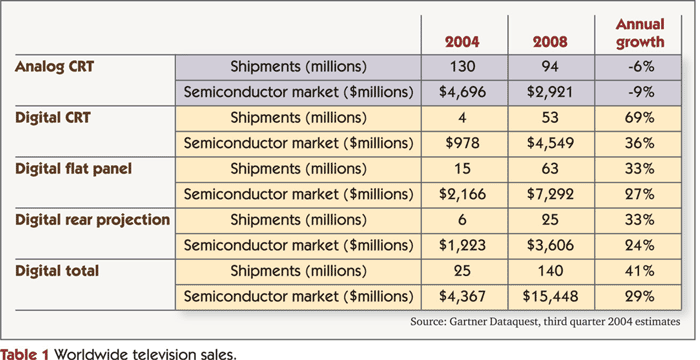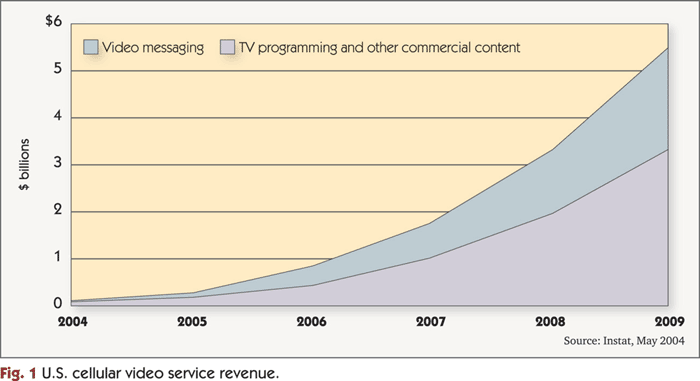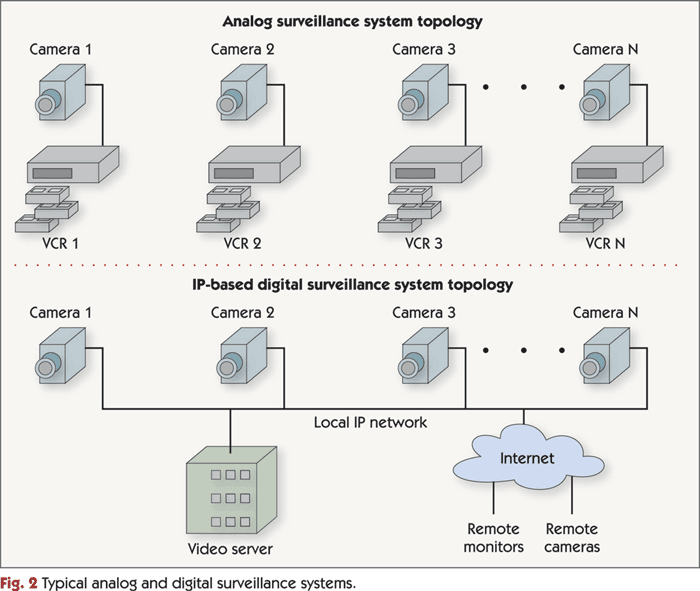Digital video technology is reshaping our lives, changing everything from how we entertain ourselves to how we protect ourselves. As digital technologies become pervasive, they are making video products more affordable, convenient, and sophisticated. In this article, we explore major developments in three digital video application areas: home entertainment, mobile video, and surveillance.
Home entertainment
Digital video has already made significant inroads into home entertainment applications. Digital television, particularly high-definition television (HDTV), is one of the most important home entertainment applications. As shown in Table 1, sales of digital televisions are expected to grow rapidly in the next few years. The introduction of low-cost flat panel displays is a primary driver for this sudden growth. Many consumers find these sleek displays desirable, but find their prices prohibitively high. However, prices may fall soon. According to a fourth-quarter 2004 projection by iSuppli, the average price for plasma flat-panel television will drop from around $3,400 in 2004 to roughly $1,100 in 2008.

The majority of HDTV sets sold to date have been very large. For example, iSuppli estimates that roughly two-thirds of the high-definition televisions sold in the last two years had a diagonal measurement greater than 25 inches—and roughly half of those sets measured 40 inches or larger. Many consumers are buying large-screen televisions for their size rather than for their ability to display high-definition video.
However, the fact that these televisions support high definition has created a market for other high-definition products and services. As a result, the “chicken-and-egg” problem that often hinders acceptance of new technologies has been partly resolved for high-definition video.
The emergence of high-definition DVDs will likely push HDTV further into the mainstream. In the US, two high-definition DVD formats, Blu-ray and HD-DVD, are expected to lead the charge. Blu-ray players are already shipping, and HD-DVD players are expected to begin shipping by the end of 2005. Unfortunately, the players suffer from high prices—both types of players cost approximately $1,000.
Price is not the only problem facing high-definition DVDs; the availability of multiple, incompatible formats is likely to confuse consumers and slow sales. Matters are particularly confusing in China and Taiwan, where an alphabet soup of high-definition formats including EVD, FVD, HVD, and HDV have been introduced. Of course, a DVD player is only useful if movies are available in the appropriate format, and it is not yet clear which formats will win the most studio support.
Consumers can also get high-definition content from broadcast television, cable service and satellite service. HDTV is important to cable and satellite service providers because new subscription rates are slowing. As a result, cable and satellite service providers are increasingly concerned with keeping existing subscribers. HDTV is one way service providers can differentiate themselves and discourage customers from switching to a different provider. Service providers are also attempting to retain customers by providing set-top boxes (STB) with integrated personal video recorders (PVRs) and by providing video-on-demand (VoD) services. Satellite service providers cannot directly provide VoD services, so they are linking up with telecommunications providers who can provide VoD via video-over-DSL. EchoStar has started trials of such services.
Set-top boxes with integrated PVRs threaten the business of standalone PVR vendors like TiVo. Similarly, successful VoD services would pose a challenge to traditional video rental outlets like Blockbuster and to DVD-by-mail companies like Netflix. Not surprisingly, TiVo and Netflix recently announced a deal to provide movie downloads to TiVo subscribers.
The TiVo/Netflix team will not be the first to offer Internet movie downloads on a consumer electronics device. A startup called Akimbo already offers a TiVo-like device that can download movies. However, Akimbo’s movie offerings are largely limited to little-known independent films, limiting the appeal of the service. Companies like Akimbo have found it difficult to obtain mainstream movies, largely due to Hollywood’s concern over pirating. Pirating can only be prevented with a rigorous, widely accepted digital rights management (DRM) system, and today’s products lack this type of DRM support. The TiVo/Netflix team clearly has its eye on mainstream films—it is in talks with Warner Bros.—but it has not explained how it will address the crucial DRM question.
The DRM problem has been largely resolved for PC-based movie services like Movielink. Because these services can download DRM software to the user’s computer, the services can easily implement high-quality DRM schemes. However, these services have limited appeal because most consumers do not want to watch movies on their PCs—and moving video content between the PC and a home theater system is still too difficult for most consumers. A key problem is that there are few widely accepted protocols describing how digital video devices should interact.
Fortunately, a solution to the connectivity quandary may be on the way. The Digital Living Network Alliance (DLNA) recently published its “Home Networked Device Interoperability Guidelines.” As the name suggests, the guidelines define a protocol for moving content between video devices on a home network. The DLNA guidelines are based on existing standards, and the organization includes many of the largest consumer electronics and computer companies. These factors may help the DLNA guidelines gain wide acceptance. The first DLNA-compliant products are expected to be available in the second quarter of 2005.
Mobile video
Digital video is also increasingly important in mobile phones. As shown in Figure 1, one mobile application that is expected to gain traction is video messaging. In this application, a user records a short video message and then sends it to another phone. One reason video messaging is growing quickly is that it does not require real-time transmission of the video stream. Hence, video messaging can be used with existing low-bandwidth phone networks. Another advantage of video messaging is that it is useful even if the receiver does not have a phone capable of playing back the video. In such cases, the message can be sent to a PC.

In most respects, video messaging is easy to implement using commonplace phone technology. However, video messaging requires real-time video compression. This can present a challenge, particularly if the user wants to capture something better than a low-resolution, jerky video clip. Consider the requirements for video compression on a typical phone processor, the ARM9: To encode a 30-frame-per-second MPEG-4 clip at a modest CIF (352x288) resolution, an ARM9 would have to operate at roughly 500 MHz—but the ARM processors used in most phones top out at just a few hundred megahertz. Video recording becomes even more challenging with the new H.264 video compression algorithm. Though H.264 provides much better video compression than older algorithms, it also requires far more computational power. To address these computational demands, phone makers are turning to a variety of innovative processor architectures.
To learn more about the H.264 codec, see “H.264: The Video Codec to Watch.” To learn more about the processors used in video applications, see “Processors for Video: Know Your Options.”
Carriers are also considering mobile video conferencing. Video conferencing has been possible on land lines for many years, but it has never taken off with consumers. A key reason for this is that with land-line video conferencing, there is little to see; the camera can only show the speaker. Mobile video conferencing allows the speaker to turn the camera around and capture the surrounding scenery.
Mobile video conferencing faces three significant hurdles. First, mobile video conferencing requires a phone to perform real-time video encoding and decoding—a challenging workload.
Second, the limited bandwidth and highly variable latencies of 2.5G networks make it difficult to deliver live video. Third, the bandwidth needed for mobile video conferencing is prohibitively expensive. Although 3G networks—which are just now being deployed—better support mobile video conferencing, 3G networks may not solve the cost issue.
Another mobile application receiving growing attention is video streaming, that is, viewing video in real time over the cellular network. Video decoding is far less computationally demanding than video encoding, so even phones with only modest processing power can handle video streaming.
However, the limited bandwidth and highly variable latencies of 2.5G networks make it difficult to stream video with a level of quality that users find acceptable. For example, the MobiTV service offered by Sprint plays video at a rate of only one or two frames per second.
At this low frame rate, a “video” looks more like a slide show. And as with mobile video conferencing, the cost of streaming video is prohibitively high. Another application, mobile television, doesn’t use the phone network at all. Instead, mobile television signals are typically broadcast using spectrum that would otherwise be used for terrestrial analog television broadcasts. (Some systems will broadcast on the 1,800-MHz portion of the cellular spectrum, and the South Korean system uses satellite signals instead of terrestrial signals.) The mobile television signals provide low resolution, low frame-rate versions of television programs.
Because the signals are broadcast in a different band than the cellular phone signals, adding mobile television requires use of a second antenna and separate RF hardware. Although these components add to the cost of the handset, mobile television has other advantages over other mobile video applications. Unlike streaming video, the content for mobile television is readily available. In addition, the user doesn’t have to pay for the data bits because the video is not being delivered over the cellular network.
Surveillance
Although consumer applications account for the largest share of the digital video market, digital video is also becoming important in a variety of non-consumer markets. Surveillance applications are a prime example of this trend.
According to J.P. Freeman Co., surveillance applications are growing at about 20% annually, both in terms of number of installations and in market value. While many surveillance systems still use analog video, these systems are rapidly going digital. According to a July 2004 study by Datamonitor, the global market for digital surveillance systems will grow from about $1 billion in 2003 to about $7 billion in 2007.The move to digital is motivated by several factors.
First, digital video storage is less costly and requires less space than analog video storage. This is an import advantage for applications that need to record massive amounts of surveillance video. Casino security systems are a prime example of this cost advantage. Until recently, casinos required a room full of VCRs to record the video feeds from the dozens of cameras keeping an eye out for cheaters. Today, a single video server can replace a room full of VCRs. Figure 2 illustrates the key differences between analog and digital surveillance systems.

Digital video systems are also easier to maintain. While the tapes for analog systems have to be swapped regularly, a large hard drive can record video for extended periods of time. Digital video systems can also be easier to install, particularly for systems that require many cameras. While analog cameras require a separate line from each camera to the control room, digital cameras can be hooked into an Ethernet network. This capability is particularly convenient for applications where an extensive Ethernet network is already installed.
The ability to connect to an Ethernet network also makes it possible to view the video from a security camera over the Internet. This capability is important for applications like traffic monitoring, where video feeds need to be sent to multiple distant control rooms. Remote viewing capabilities are also important for home security systems, where they allow a homeowner to check on the house.
Although the ability to connect a camera to an Ethernet network has several advantages, it also presents significant challenges. One key challenge is that a security system must be extremely reliable. Although corporate IT networks can be highly reliable, they generally do not achieve the level of reliability needed for a surveillance system. Corporate IT networks may also lack the bandwidth needed to carry all of the surveillance system’s video streams. Although it is often possible to upgrade a corporate IT network to make it suitable for surveillance applications, doing so may require substantial investments. Not surprisingly, J.P. Freeman Co. reports that about 40% of Ethernet-based surveillance systems use a dedicated network, rather than patching in to an existing network.
In general, today’s digital surveillance systems simply replace analog components with digital components. However, forthcoming digital surveillance systems will offer advanced features such as object tracking. For example, an airport security system might alert its operators if a passenger leaves a package unattended. Such features are appealing for two reasons.
First, although human operators can perform such functions, an automated system won’t become bored and inattentive. Second, an automated system may be able to reduce the number of operators required, thereby reducing operating costs.
Although digital surveillance systems can offer numerous long-term cost advantages, the initial costs for digital equipment can be significantly higher than the costs for analog equipment. This is particularly true for digital systems with advanced features such as object tracking. These features require substantial processing power and sophisticated, specialized software. Lowering the prices of this hardware and software is a key challenge for digital surveillance equipment providers.
Looking forward
The opportunities in digital video have never been brighter. Digital video technology is quickly replacing existing analog video technology, and it is enabling entirely new classes of products and services. At the same time, digital video markets pose a number of daunting challenges. For example, in home entertainment markets, digital video technologies must overcome confusion over competing standards.
For mobile applications, the main challenges lie in providing sufficient bandwidth and processing power at acceptable prices. Cost is also a challenge for surveillance applications, where equipment prices are the key concern. Without a doubt, the next few years will be pivotal for many digital video applications.


Add new comment